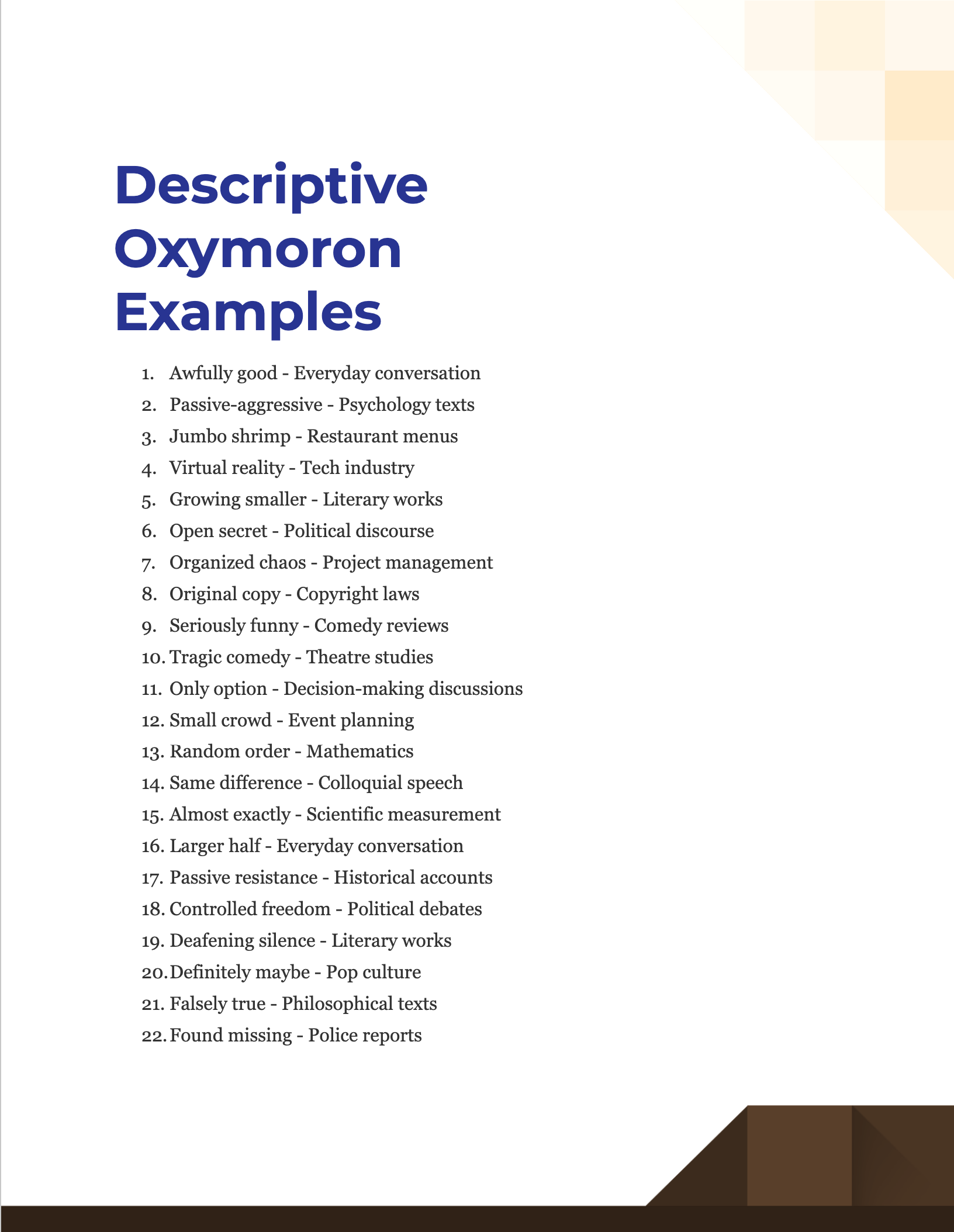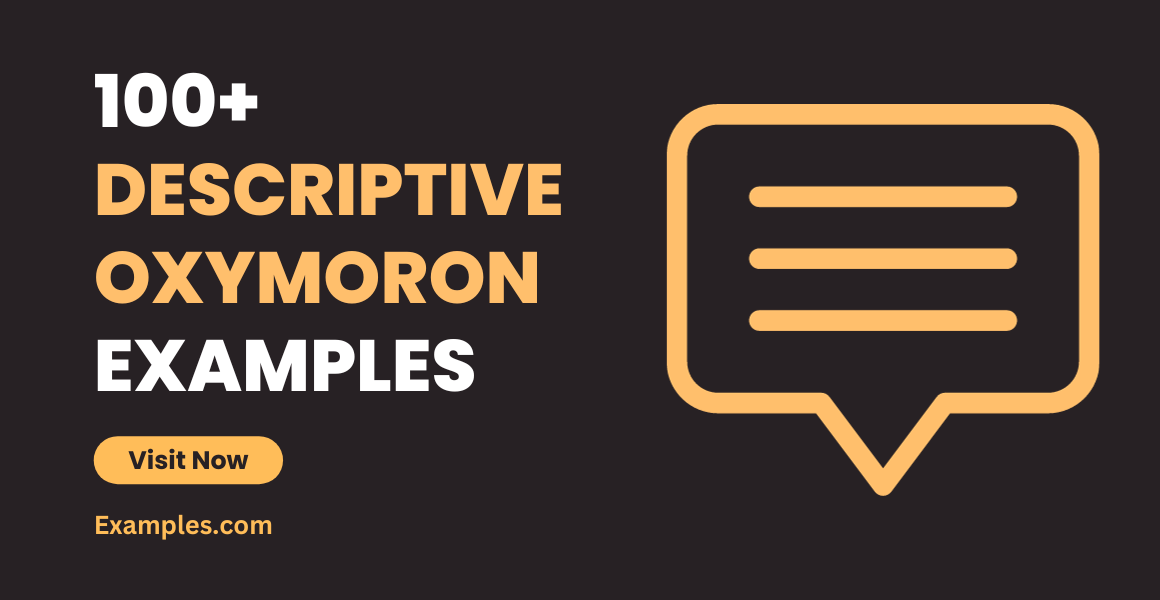99+ Descriptive Oxymoron Examples
Elevate your writing game with descriptive oxymorons! These intriguing figures of speech add layers of complexity and nuance to your prose. From literature to everyday conversation, descriptive oxymorons captivate the mind and ear. Dive into our comprehensive guide to discover how to construct these compelling contradictions and use them to enrich your writing. For more insights on how oxymorons are used in different contexts, check out our article on Oxymorons in Literature.
What is a Descriptive Oxymoron? – Definition
A descriptive oxymoron is a figure of speech that combines two contradictory terms to create a new, evocative meaning. Unlike regular oxymorons, these specifically add rich detail and vivid imagery to the subject they’re describing. To explore more about the figure of speech aspect, read our guide on Oxymoron as a Figure of Speech.
What is the best Example of a Descriptive Oxymoron?
The phrase “deafening silence” stands out as a quintessential example of a descriptive oxymoron. Here, the term “deafening” contradicts the general notion of “silence” as being quiet. But when fused together, they paint a vivid picture of a silence so overpowering that it feels loud. This descriptive oxymoron adds a layer of emotional intensity, making it more impactful than using the word “silence” alone. For more such intriguing examples, you can visit our Oxymoron Examples page.
100 Descriptive Oxymoron Examples

Unearth the magic of language with our curated list of 100 descriptive oxymorons. These captivating figures of speech add layers of meaning, making your conversations and writings intriguing. Whether it’s in literature, dialogue, or poetic verse, our handpicked examples promise to breathe life into your language skills. If you’re interested in how these can be funny, check out our Funny Oxymoron examples.
- Awfully good – Everyday conversation
- Passive-aggressive – Psychology texts
- Jumbo shrimp – Restaurant menus
- Virtual reality – Tech industry
- Growing smaller – Literary works
- Open secret – Political discourse
- Organized chaos – Project management
- Original copy – Copyright laws
- Seriously funny – Comedy reviews
- Tragic comedy – Theatre studies
- Only option – Decision-making discussions
- Small crowd – Event planning
- Random order – Mathematics
- Same difference – Colloquial speech
- Almost exactly – Scientific measurement
- Larger half – Everyday conversation
- Passive resistance – Historical accounts
- Controlled freedom – Political debates
- Deafening silence – Literary works
- Definitely maybe – Pop culture
- Falsely true – Philosophical texts
- Found missing – Police reports
- Living dead – Horror genre
- Minor miracle – Religious discussions
- Negative growth – Economic reports
- Old news – Media outlets
- Peaceful war – Political discourse
- Poorly executed brilliance – Art reviews
- Quiet riot – Social studies
- Resident alien – Immigration laws
- Rolling stop – Traffic rules
- Sad smile – Emotional expression
- Simplex complex – Mathematics
- True myth – Cultural studies
- Unbiased opinion – Journalism
- Unknown knowledge – Scientific research
- Unplugged electric – Music industry
- Walking dead – Horror genre
- Wise fool – Literary works
- Act naturally – Acting classes
- Found lost – Adventure stories
- Freezer burn – Culinary terms
- Liquid gas – Chemistry
- Mandatory option – Contractual language
- Openly hidden – Mystery novels
- Plastic glasses – Fashion industry
- Silent scream – Psychological studies
- Soft rock – Music reviews
- Civil war – History books
- Constant variable – Scientific research
- Crash landing – Aviation reports
- Detailed summary – Academic writing
- Dry ice – Chemistry
- Exact estimate – Construction planning
- Freezer burn – Culinary terms
- Guest host – Television industry
- Historical future – Science fiction
- Inside out – Fashion industry
- Known secret – Intelligence agencies
- Larger half – Mathematical discussions
- Lesser evil – Moral philosophy
- Liquid gas – Scientific research
- Living history – Museums
- Mandatory choice – Political debates
- Original remake – Film industry
- Passive activity – Leisure studies
- Permanent substitute – Employment terms
- Plastic silverware – Dining out
- Poorly rich – Social discourse
- Preliminary conclusion – Research papers
- Recorded live – Music albums
- Scenic route – Travel guides
- Small fortune – Financial planning
- Terribly pleased – Emotional expression
- Virtual reality – Gaming industry
- Walking corpse – Medical literature
- Actively lazy – Self-help books
- Advanced beginner – Skill level classifications
- Alone together – Relationship studies
- Awkward grace – Dance reviews
- Black light – Science
- Busy idleness – Productivity discussions
- Cautious optimism – Business outlook
- Clearly misunderstood – Communication studies
- Dark light – Photography
- Deep shallows – Oceanography
- Dull shine – Car maintenance
- Empty fullness – Philosophical texts
- Fast turtle – Children’s literature
- Feeble strength – Physical therapy
- Full void – Cosmology
- Genuine imitation – Marketing
- Hard pillow – Sleep studies
- Heavy feather – Artistic expression
- High lows – Music theory
- Innocent guilt – Legal terms
- Joyful sorrow – Emotional studies
- Known unknowns – Risk assessment
- Light darkness – Theological discussions
- Minor crisis – Emergency management
Can you describe someone as an oxymoron?
Certainly, describing someone as an oxymoron is an interesting approach to capture the complexities and contradictions inherent in human nature. For instance, someone can be described as a “quiet extrovert,” which initially sounds contradictory but accurately represents people who are social yet reserved. This usage is particularly prevalent in psychology and personality studies, where nuances often defy simplistic labeling. For more on this, explore our article on Emotional Oxymorons.
The real beauty of using an oxymoron to describe someone lies in its ability to provoke thought and stimulate deeper understanding. It can be a potent tool for writers, psychologists, and anyone interested in exploring the multi-faceted aspects of human personality. In literature, characters often described with oxymoronic traits often turn out to be the most compelling and relatable. These descriptions not only enrich character development but also make storytelling more engaging and multidimensional.
Is sad smile an oxymoron?
The phrase “sad smile” is a perfect example of a descriptive oxymoron that encapsulates the complexity of human emotions. While smiling is typically associated with happiness or pleasure, it can also serve as a mask for other feelings, such as sadness. This dual nature of a “sad smile” captures an emotional experience that many find relatable, making it a powerful expression for writers, poets, and anyone aiming to convey nuanced emotional states. For more on how oxymorons are used in poetry, read our article on Oxymorons in Poetry.
In psychological terms, a “sad smile” can be a way of coping with negative emotions, acting as a social signal to others, or even a personal mechanism for trying to uplift one’s mood. It’s a particularly compelling oxymoron because it engages the audience on a visceral level, provoking them to think about the multifaceted nature of emotions. In literature or film, characters who exhibit a “sad smile” are often those undergoing internal conflict, making this oxymoron a useful tool for creators aiming for depth and emotional resonance.
Both these phrases, “quiet extrovert” and “sad smile,” serve as testaments to the power and utility of descriptive oxymorons in articulating the intricacies of human nature and emotion. So, the next time you find yourself grappling with an experience or a character that defies simple description, consider the expressive potential of oxymorons.
How do you write a Descriptive Oxymoron? – Step by Step Guide
Crafting a descriptive oxymoron involves a keen eye for detail and an understanding of the complexities of language and emotion. Here’s a step-by-step guide to help you create your own. For a more child-friendly approach to teaching oxymorons, you might want to read Oxymorons for Kids.
- Identify the Subject: Decide what or who you want to describe. It could be a character, an object, a setting, or even a situation.
- List Contrasting Elements: Think of words or phrases that generally describe the subject, and then find contrasting or seemingly contradictory terms. For example, if you’re describing a fearless character who is surprisingly shy in love, the terms to think of might be “fearless” and “shy.”
- Combine Skillfully: Pair the contrasting words in a way that they produce a meaningful description. In our example, you might coin the phrase “fearless romantic timidity.”
- Test for Clarity: Make sure your oxymoron makes sense within the context it’s being used. The purpose of an oxymoron is to provoke thought, not to confuse the reader.
- Use Sparingly: Like any literary device, oxymorons are most effective when used in moderation. Overuse can dilute the impact.
- Refine and Revise: Once you have penned down your descriptive oxymoron, go back and refine it. Ask yourself if it truly adds depth and complexity to your subject.
- Contextualize: Integrate your oxymoron seamlessly into sentences, ensuring it complements the surrounding text and enriches the narrative.
- Review: Go through your text to ensure the oxymoron fits and enhances your writing. Revise as necessary.
Tips for Using Descriptive Oxymoron
- Understand the Purpose: Know why you’re using an oxymoron. Is it to reveal a character’s complexity, add depth to a setting, or to make a statement? For more tips and examples that are sure to make you laugh, check out Comical Oxymorons.
- Audience Awareness: Consider your audience’s familiarity with oxymorons and their likely response. Avoid overly complex oxymorons if your audience prefers straightforward language.
- Simplicity is Key: While oxymorons are complex by nature, they shouldn’t be overly complicated. Aim for simplicity in the words you choose.
- Seek Authenticity: Your oxymorons should arise naturally from the subject matter. Forced or artificial oxymorons can disrupt the flow of your writing.
- Embrace Ambiguity: Oxymorons thrive on ambiguity, capturing the nuances of complex subjects. Don’t shy away from this quality.
- Be Consistent: If you’re using multiple oxymorons in a piece, they should all serve a consistent purpose and reflect a similar tone.
- Review and Revise: Always review your use of oxymorons in the context of the broader piece. If an oxymoron doesn’t serve the writing or appears forced, consider revising or removing it.
- Get Feedback: Sometimes, it’s helpful to get a second opinion. Share your writing with someone else to gauge if your oxymoron has the desired effect.
By following these guidelines, you can craft descriptive oxymorons that add depth, intrigue, and nuance to your writing, enriching both your characters and narratives.



